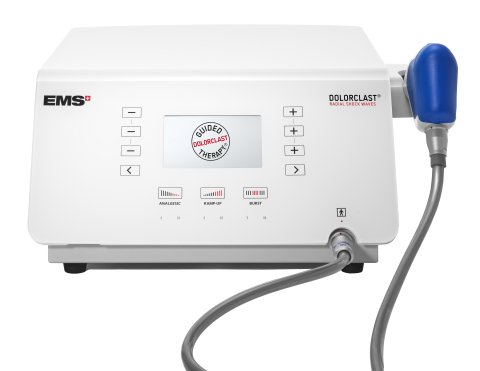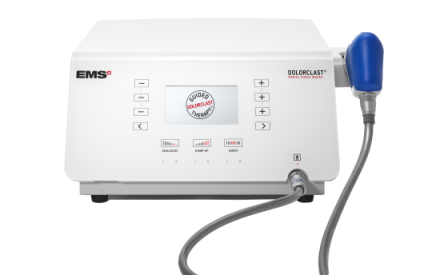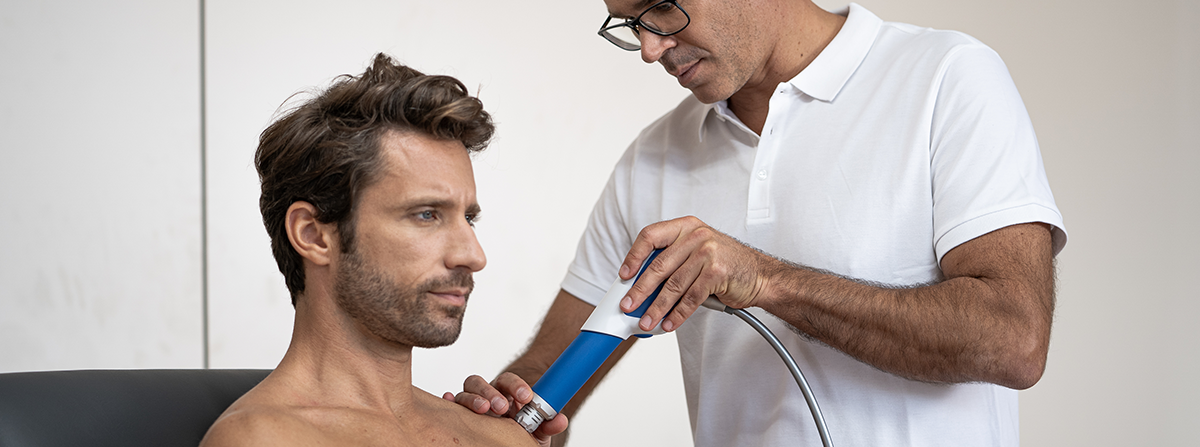
DolorClast® Radiale Stoßwellen
Interested in learning more about radial shock wave therapy?
Click to access EMS' recently published e-book:
What are the benefits of shock wave therapy?
Extracorporeal Shock Wave Therapy (ESWT) is the application of Shock Waves in medicine.
It is clinically proven that pressure waves, when applied to injured tissues, stimulate metabolic reactions:
- Reduction of pain felt by nerve fibers
- Increase of blood circulation in surrounding soft tissues
- Beginning of healing process triggered by stem cells activation
The sound of healing with radial shock waves

How can shock wave therapy help in physical therapy?
- Compressed air accelerates a projectile which strikes a fixed applicator.
- The kinetic energy is converted into a shock wave delivered to the target tissue through the skin.
- These shock waves are conveyed radially for broad treatment areas.
-
A shock wave begins by a compression phase. The peak pressure creates shear stress in the tissues.
-
A tensile phase follows and generates cavitation bubbles. A high cavitation level is a result of a high amount of energy density delivered by the shock wave device.
-
This energy stimulates metabolic reactions to the applied tissues
Wie kann man mit Stoßwellentherapie erfolgreich sein?
Ganz einfach: Je mehr Energie in das Gewebe eingebracht wird, desto besser das therapeutische Ergebnis. Dazu wissen wir Folgendes:
"Ein signifikanter Effekt im Gewebe ist die Kavitation als Folge der negativen Phase der Wellenausbreitung" (Ogden et al., 2001)
"Beide Parameter (Kompressionsphase und Kavitation) können wichtige Konsequenzen für den therapeutischen Bioeffekt haben" (Perez et al., 2014)
"Der Beitrag der Kavitation zur therapeutischen Wirkung von radialen Stosswellen wurde kürzlich in einem fortgeschrittenen Tiermodell gezeigt" (Angstman et al., 2015)
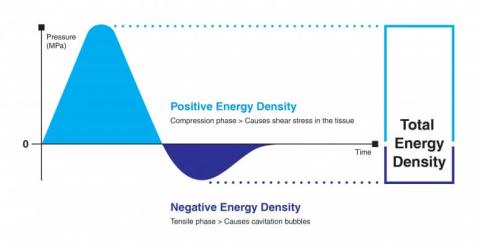
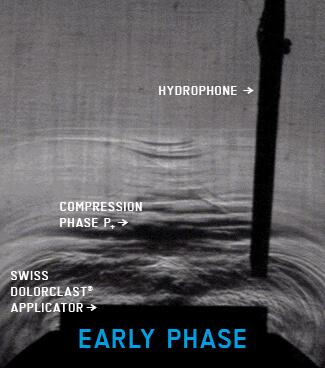
Radial shock waves visualization
The compression phase (P+) penetrates the skin
and weakens the tissue.
A tensile phase (P-) follows generating
cavitation bubbles.
These bubbles collapse causing secondary shock waves.
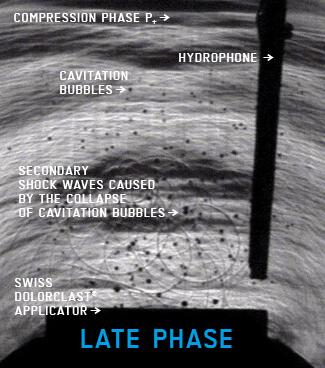
How do radial shock waves work?
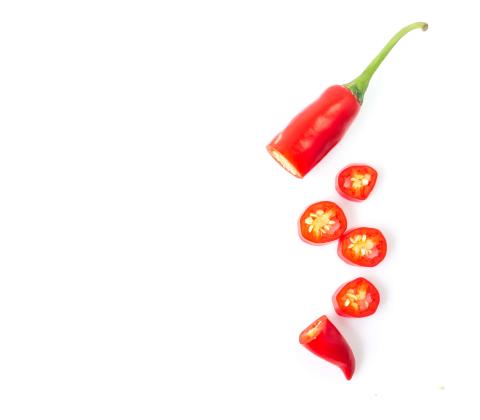
Red chili peppers contain capsaicin. At first this substance overwhelms the so-called C nerve fibers responsible for transmitting pain but then disables them for an extended period of time.
Everybody knows the feeling – first, the mouth is on fire, then it feels completely numb. Research has indicated that shock wave therapy works the same way1.
1 Maier et al., Clin Orthop Relat Res 2003; (406):237–245.
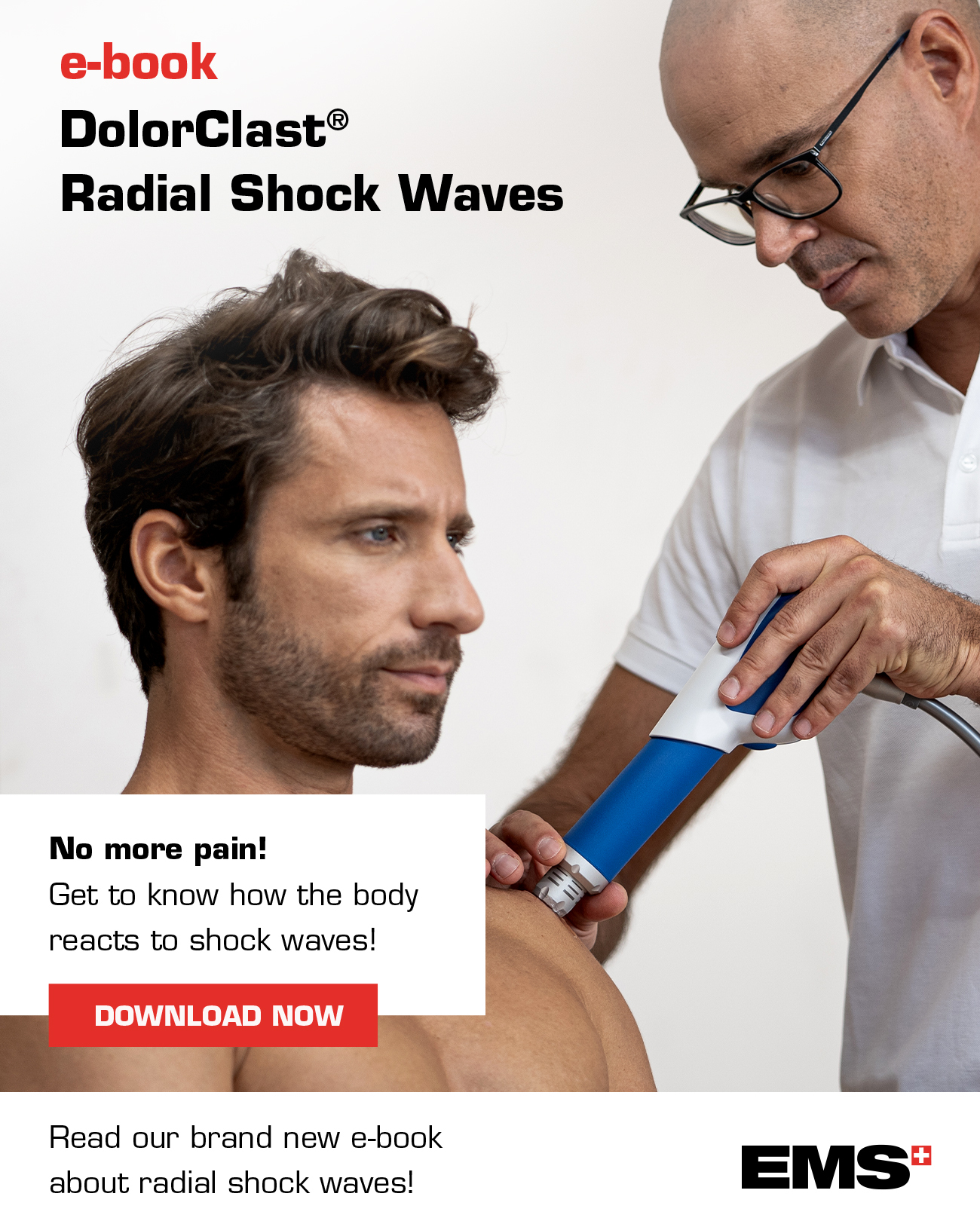
Laden Sie unser E-Book über die DolorClast® Radial Shock Waves herunter
- Was ist die radiale Stoßwellentherapie?
- Wie kann sie zur Behandlung von muskulo-skelettalen Erkrankungen eingesetzt werden?
- Wie wirken sie auf den Körper?
- Was sind die Indikationen und Kontraindikationen?
Was Sie schon immer über die radiale Stoßwellentherapie wissen wollten und mehr in unserem neuen E-Book!
Introducing: DolorClast® Radial Shock Waves
Was sind DolorClast® Radiale Stoßwellen?
1997 patentierte EMS das erste radiale Stoßwellengerät, den Swiss DolorClast®, der auf dem ballistischen Prinzip basiert.
Druckluft, die an das Handstück geschickt wird, beschleunigt ein Projektil, das mit hoher Geschwindigkeit (bis zu 90 km/h) auf einen feststehenden Applikator trifft. Die aus dieser Bewegung resultierende kinetische Energie wird in eine Stoßwelle umgewandelt, die radial auf das Zielgewebe übertragen wird.
Die Abgabe der Stoßwellen erfolgt in kurzer Zeit, in der Regel dauert sie nur wenige Minuten, so dass sie, wie von der GDT empfohlen, innerhalb derselben Sitzung mit anderen Therapien gekoppelt werden können. Das DolorClast®-Stoßwellenprotokoll umfasst in der Regel insgesamt drei bis fünf Sitzungen, die in einem Rhythmus von ein bis zwei Sitzungen pro Woche mit einem Intervall von mindestens 72 Stunden dazwischen geplant werden.
Given that DolorClast® Radial Shock Waves delivers the highest energy density, no wonder that it generates the highest amount of cavitation in the treated tissues.
Welche Stoßwellengeräte erzeugen am meisten Kavitation?
Die Bilder unten stellen die maximale Kavitationsstufe (schwarze Punkte) dar, die mit verschiedenen radialen Stoßwellenhandstücken bei maximalen Druckeinstellungen bei 15Hz erzeugt wird.1

1 NikolausB. M. Császár et al., “Radial Shock Wave Devices Generate Cavitation”, 2015.
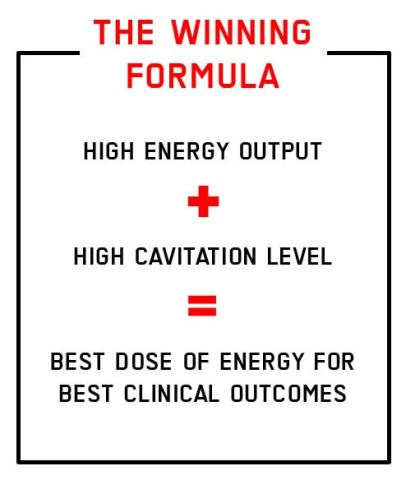
Clinical researches1 show that therapeutic effects of RSWT® are linked to the level of cavitation produced in the treated tissues.
And, a high cavitation level is a result of a high amount of energy density delivered by the devices’ handpieces.
The higher the total of the energy density is, the better the treatment outcomes will be.
1 Perez et al., 2014 / Angstman et al., 2015 / Ogden et al., 2001 / Maier et al., 2003 / Hausdorf et al., 2008.

DolorClast® Radial Shock Waves – The Swiss original in worldwide pain treatment
- 34 / 62 randomized controlled trials: used in more studies listed in the PEDro database than any other ESWT device
- Over 13'000 units in use worldwide
- More than 100 Million patients treated worldwide
Die Guided DolorClast Therapy schlägt eine Kombinationstherapie vor:
Wenden Sie DolorClast® Radiale Stoßwellen an:
- 5 Minuten nach Ende der Behandlung mit dem DolorClast®-Hochleistungslaser für ausgezeichnete kombinierte klinische Ergebnisse, oder
- 1 Stunde nach Ende der Behandlung mit dem DolorClast® High Power Laser für optimale kombinierteklinische Ergebnisse
A recent study by Prof. Dr. med. Christoph Schmitz from LMU, University of Münich, Germany, showed that thanks to this combination, it is possible to deliver up to 50% more energy just 5 minutes after the laser pre-treatment and up to 100% when waiting one hour in between!

